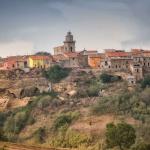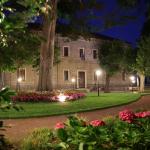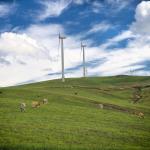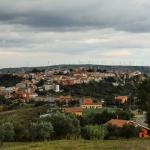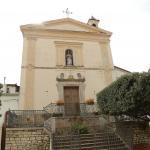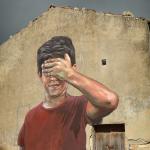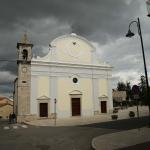The Municipality of Lacedonia is located in the Upper Irpinia area. It's a town with 2,203 inhabitants, located 734 metres above sea level, at 81 km from Avellino. The territory extends for 82.10 sq km and the adjoining municipalities are: Aquilonia, Bisaccia, Melfi, Monteverde, Rocchetta Sant'Antonio, Sant'Agata di Puglia and Scampitella. It's crossed by the Ofanto river and the Osento and Vallone Isca streams.
The etymology of the name seems to derive from the language of the Osci, who called this land Akudunniad which means "Mother stork"; the stork, not surprisingly, appears in the symbol of Lacedonia, starting from 212 BC, when this bird took the place of the eagle. Later called Erdonea, probably by one of its conquerors, it was subsequently called Al Cidonia and Cedogna until 1800, when it was finally called "Lacedonia". The inhabitants are called Lacedoniesi and Saint Nicholas and Saint Philip Neri are their patron saints.
PLACES OF INTEREST
- Castle of Pappacota - Also called "Castle of Pappagoda", it dates back to the 16th century: only one of the towers and part of the mighty body of the building remain
- MAVI (Visual Anthropological Museum) - Exhibition set up inside a 19th-century building, consisting of 1,801 photographic shots of the American anthropologist Frank Cancian and focused on the rediscovery of the rural culture of Lacedonia
- Origlio woods - Green area with mineral springs, centuries-old oaks and Lake Saint Peter, where there are the monumental trees called "Cerro del Tesoro" (Turkey Oak of the Treasure) and "Cerro del Drago" (Turkey Oak of the Dragon), which were declared of regional importance
- Co-Cathedral of Santa Maria Assunta (Saint Mary of the Assumption) - Built in the 17th century, it's also known as the "Church of Santa Maria Assunta" and has a travertine bell tower
- Church of Santa Maria della Cancellata (Our Lady of the Gate of Dawn) - Very ancient church which, in Roman times, was dedicated to the goddess Isis
- Church of San Filippo Neri (Saint Philip Neri) - Church dedicated to the patron saint of Lacedonia, located in the square dedicated to Francesco De Sanctis
- Sanctuary of the Madonna delle Grazie (Our Lady of Graces) - Rural church located outside the town centre, at the foot of a hill: inside, the statue of the Most Holy Virgin is preserved
- Church of Santissima Trinità (Holy Trinity) - Small chapel of very ancient origins, rebuilt in the 17th century
- Church of the Consolazione (Our Lady of Consolation) - Deconsecrated religious building, in which there is a 16th-century column called "Colonna del Pedoca"
- Diocesan Museum of Saint Gerard - Inaugurated in 1997, it's dedicated to Saint Gerard Majella
- Episcopal Palace - Known for hosting Saint Gerard Majella
- House of the Devil - Structure that, according to the legend, was built in one night by the "devil" and which is located in the balance on the tuff cliff of the town, where, although without foundations, it has resisted several earthquakes
- Sources of the Osento river - The Osento river feeds Lake Saint Peter and its sources are a place of environmental, cultural and historiographical value, since important archaeological remains have been found in this area
- Valley of the Osento river - The valley carved by the Osento is particularly suitable for visits by people interested in both floral and animal biodiversity. It's idea also for trekking
- Cave called "Urtacchio della corte" - One of the largest tufaceous caves in the town, an important sacred place since the Samnite era
- Rocky path of the tufaceous caves - Path that has over 150 caves, inhabited since the end of the Pleistocene, as evidenced by the discovery of finds dating back to over 13,000 years ago
- Cliffs of Saint Blaise and brigands’ caves - Located between the hill called "Il Monte" and Mount Origlio, they are dotted with a multitude of caves
- Contrada Forna (Forna District) - Archaeological area where, over the decades, a huge amount of artefacts preserved in various museums has been found. Nearby, in the 16th century, there was a Benedictine hermitage of which, however, traces have been lost
- Nature trails - Mount Pauroso path and Serrone and Macchialupo districts path
- Other churches - Church of S. Rocco (Saint Roch), Church of S.Nicola (Saint Nicholas), Church of the Spirito Santo (Holy Spirit), Church of the Purgatory, Church of S. Maria della Consolazione (Our Lady of Consolation)
EVENTS
- Feast of Our Lady of Graces - Celebrations and procession in honour of the Madonna
- Feast of Saint Philip Neri - Traditional celebrations that last a few days, in the second half of May, accompanied by the performance of musical and theatrical artists
- Carnival - Celebrations with allegorical floats, masks and chiacchere (typical sweets of the feast)
- Fire of Saint Joseph - Tradition of the 18th of March in which large bonfires are set up
- Feast of Saint Gerard Majella - Feast dedicated to Saint Gerard, scheduled every year on the 16th of October
- Feast of Saint Nicholas - Celebrations in honour of the patron saint on the 6th of December
- Annual program of the municipal theatre of Lacedonia - It includes at least ten shows per season by top national companies, and many musical concerts
- Historical re-enactment of the conspiracy of the Barons - Event during which the salient moments of the oath pronounced on the 11th of September 1486 are staged, with a procession in historical clothing that runs through the streets of the town and a public dinner with medieval dishes
- Calici in centro - Event held on an August evening, during which the best Irpinia wine producers occupy the tuff caves of the historic centre and offer a tasting to customers
- Photo contest "1801 Passaggi" - Photographic competition in which people from numerous areas participate and which, every year, provides a very specific theme to inspire them
- Living Nativity scene and Via Crucis - Events held at Christmas and around Easter respectively
TYPICAL FOOD AND PRODUCTS
- Masciatica olive PAT - Medium-sized fruit with medium-late ripening, sometimes used to make an oil with a fruity aroma and a sweet taste
- Cauzuncielli - Desserts baked in the oven, similar to stuffed ravioli, prepared with chestnut paste and chocolate
- Sfogliatelle - Cake filled with sweet ricotta or black cherry jam
- Asparaguses - Present in large quantities in the undergrowth of Contrada Forna
- Caciocavallo Silano PDO - Semi-hard cheese, with spun curd, produced with milk from different breeds of cows, including Podolica
- Caciocavallo irpino di grotta PAT - Spun curd cheese, produced with milk from small and medium-sized farms, mainly from brown cattle, traditionally aged in caves
FUN FACTS
Transhumance, an ancient practice of pastoralism which consists in the seasonal migration of livestock in the Mediterranean and the Alps, was included by UNESCO in the List of Intangible Cultural Heritage in 2019, recognizing the value of the practice on the basis of a transnational application presented by Italy, Austria and Greece: this result allowed Lacedonia to enter a circuit of great cultural importance.
The "Francesco De Sanctis" Comprehensive Institute of Lacedonia is one of the first schools built after the unification of Italy and was founded by the great statesman Francesco De Sanctis (1817-1883), the Minister of Education of the time.
Lacedonia has a wonderful 300-year-old tree, the "Cerro del Tesoro", recognized as a monumental tree.
HISTORICAL NOTES
The history of Lacedonia dates back to the Aeneolithic age. This is confirmed by the findings of copper weapons and other artefacts found in its territory. The first certain information date back to the Osci era and the remains of buildings erected under the domination of different peoples are visible in the town. There are archaeological finds of the Roman era such as swimming pools, spas, amphitheatre, wash houses, public gardens and, in the locality called "Capi acqua", those of a station intended for the change of chariots and horses (so-called "mutatio").
Of the many historical episodes rebuilt over time and reported on the site of the Municipality of Lacedonia, we remind the participation in the third crusade, with the sending of sixty foot soldiers and sixty horses by Riccardo Balbano, when the fief was under the domination of the Normans.
Also Lacedonia, like several Irpinian towns, has suffered damage as a result of seismic episodes like the earthquake of the 5th of December 1456. After the latter the Orsini family, who owned the fief at that time, rebuilt the destroyed city also creating a wall with a moat and four gates to protect the city.
Transhumance shapes the relationships between people, animals and ecosystems, implies shared rituals and social practices, it represents an invitation with open arms to Lacedonia, to live a tradition that has always been renewed
Lacedonia
Corso Giovanni Amendola, 10, 83046 Lacedonia AV, Italia
Events
-
A popular tradition in which the statue is carried in a procession on foot to the town and…
On April 6th at 8.30pm the political comedian will bring his last show to the stage
Saturday 28 December Marc Angelet's theater show with Sergio Muniz and Miriam Mestururino. A…
Saturday 1 February at 8.30pm the unmissable show at the Teatro Comunale
Featured places
Lago di San Pietro, 83049 Monteverde AV, Italia
An artificial lake immersed in the greenery of boundless woods is the setting for "The Great…
Piazza Francesco De Sanctis, 83046 Lacedonia AV, Italia
Originally conceived as a real fortress, it has undergone numerous restorations over the years…
Via Tribuni, 61, 83046 Lacedonia AV, Italia
The exhibition, housed in a 19th-century building, comprises 1,801 photographs of rural life…
Did you like it? Leave a review
Your opinion is important! It will be visible after approval by the editorial staff.
To post a comment you must be an authenticated user. Log in with Social Login
